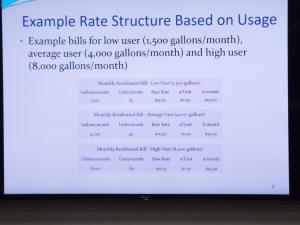|
New Lincoln sewer system to cost
$20 million
CMT offers how to pay for it
 Send a link to a friend
Send a link to a friend
 [January 11, 2018] [January 11, 2018]
LINCOLN
At the
Tuesday night meeting of the Lincoln City Council, aldermen heard a
report from Christy Crites and Shannon Brady of Crawford, Murphy,
and Tilly on the city’s ongoing Long Term Control Plan for the sewer
department.
The LTCP has been an ongoing project for the past several years, and
revolves around updating the city’s sewerage system so as to avoid
repeated overflows of sewerage into the natural waterways.
Within the plan, CMT has designed an upgrade to the waste treatment
plant at the south side of the city and also has redone the design
and location of the Union Street Lift Station. These upgrades should
bring the city into compliance regarding the number of times raw
sewerage enters into natural waterways due to heavy rains and
subsequent flooding.
The city must perform these upgrades according to a mandate from the
Illinois Environmental Protection Agency. With the plan now drawn
out, the city has five years to complete the upgrade which will cost
approximately $20 million.
Though the state, via the IEPA has mandated this upgrade, it is
considered a ‘un-funded’ mandate, which means the city is on its own
in figuring out how to pay for the project.
Crites and Brady explained that the city will need to secure an
estimated $20 million through a low interest loan or through the
issuance of bonds.
The state also mandates that city sewerage systems have to be
self-sufficient, which means the city cannot make loan payments from
the general revenue funds. The payments must be made from sewerage
system fees.
Crites and Brady estimated that the interest on two loans would be
two to two-and-a-half percent bringing the annual payments to
between $1.2 and $1.4 million.
Tuesday evening, Crites and Brady offered up two suggestions of how
to cover the loan payments, recommending the second one as the best.
Currently, the city of Lincoln bills the sewerage usage on a flat
rate for residential consumers. That rate is $24 per month, billed
quarterly. The first recommendation was to raise the flat rate to
residential consumers by $19 per month to a total of $43 per month.
This would equate to an annual increase of $228 per year, raising
the annual rate from $288 to $516 per year. There would also be an
increase to commercial rates that has not been determined yet.


According to the Illinois EPA, consumers should expect to pay
one-and-a-half percent of their median household income for sewer
service. Brady said that in Lincoln that percentage would equate to
$53.13 per month, so the increase to $43 per month would be within
those parameters. It was also noted that the Federal EPA guideline
states a household should expect to pay a full two percent of the
median income for sewer services. That figure would equate to $70.83
in Lincoln.

However,
Brady and Crites offered up a second option that would be more
equitable for consumers, based on the household water usage. They
presented a chart showing that 19 percent of Lincoln residents use
1,500 gallons or less of water per month. Forty-five percent of
Lincoln residents use between 1,600 and 4,000 gallons of water per
month, 30 percent use between 4,100 and 8,000 gallons per month and
6 percent used more than 8,000 gallons per month.

They
recommended that the city consider switching from a flat fee for
sewerage to a fee utilizing a base rate plus a usage fee.

[to top of second column] |


For this
scenario the base rate would be established at $15.50 per month for
all residential users. There would then be a usage fee of $0.50/100
gallons of water consumed through Illinois American Water.
For those using 1,600 gallons or less of water per month, the total
monthly sewerage fee would drop by $1. Those in the average usage
range of 4,000 gallons of water per month would pay $35.50 per
month, and those high volume users consuming 8,000 gallons of water
per month the rate would increase to $55.50. The actual amount
billed would change monthly dependent upon actual water consumed.

Crites and Brady noted that the city had passed a rate increase of
$1.00 every two years on city sewerage, with an increase taking
place in 2017. They recommended that the city continue on with that
$1.00 increase adding it to the new base rate at the appropriate
intervals.
Crites explained that changing the billing structure would increase
the revenues substantially, but there still needs to be a similar
study done on industrial or commercial usage. Brady will be meeting
with the city’s sewer billing department soon to get to work on a
recommendation for those rates as well.
They also explained that the re-payment plan for the loan has to be
submitted and approved by the Illinois EPA, so the city needs to
keep moving forward with the decisions on rate adjustments.
In addition, they explained that in other cities where this same
change has taken place, there has been an instant reduction in water
usage.
During the discussion period Steve Parrott asked if that reduction
was certain. Brady said it was certain based on experience of other
cities who switched from flat rate billing to usage billing and saw
the drop immediately in every case. She noted that in some ways this
is a good thing because it brings residents to the point of choosing
to invest in water saving appliances, but at the same time, the city
of Lincoln can expect to see a loss of revenue at the start of the
program.
Michelle Bauer commented that while the Long Term Control Plan is an
unfunded mandate where the city has no choice but to move forward,
her desire was to provide a rate schedule that was fair and
equitable for the residents of Lincoln.
Bauer asked about the time schedule for CMT, understanding the rate
adjustments need to be approved by the state. Brady said that CMT
plans to return to the council in two weeks with the information
about commercial rates. Even though the residential rate change will
increase the city’s sewerage department revenues, it won’t be enough
to cover the loan payments. Commercial rates are also going to have
to change. The council will need to review options for residential
and commercial billing, choose the options they feel work best, and
will then draft and pass an ordinance that reflects those choices.
When the ordinance has been passed, CMT will submit the new rate
structure to the IEPA for approval. Approval should take about six
months. Once approved by the IEPA, the city may then move forward
with securing the loans.

City Clerk Peggy Bateman asked how the city would obtain the water
usage figures and was told they would be provided by Illinois
American Water. Bateman said that the city currently relies on
Illinois American for commercial usage figures and the company is
not easy to work with.
Bateman also told the council that the computer software for the
sewer billing department is in the process of an upgrade with a new
program scheduled to go online March 1st. She said the city had a
cash investment in that upgrade, and changing it again would mean
additional cash expenditures. She urged the council to move quickly
on their decisions so she could determine how to proceed with the
software.
The Tuesday night presentation was for informational purposes only,
there will be no voting item on the agenda next week. Aldermen will
hear the future report concerning commercial rates, then make a
decision on how an ordinance should be drafted for final approval.
[Nila Smith]
Past related
article
01/06/2014 -
Lincoln contracts with CMT for long-term
sewage control plan |